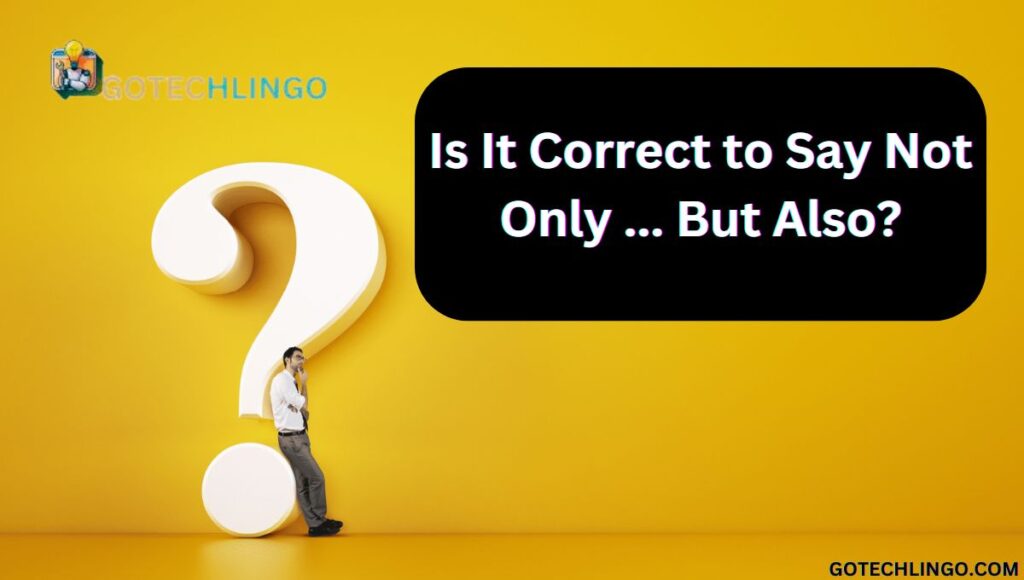In the rich tapestry of the English language, finding the perfect way to express dual emphasis can transform your writing. Today, we’ll explore the versatile phrase “not only … but also” and discover elegant alternatives that’ll enhance your communication skills.
How to Use Not Only But Also
The cornerstone of effective writing lies in understanding how to properly employ this correlative conjunction. “Not only … but also” serves as a powerful tool to emphasize two related ideas, actions, or concepts.
Key Usage Guidelines:
- Maintain parallel structure
- Balance both parts of the sentence
- Ensure logical connection between ideas
Here’s a practical breakdown:
| Correct Usage | Incorrect Usage |
| He not only speaks French but also writes it fluently. | He not only speaks French but also he writes it fluently. |
| The film was not only entertaining but also educational. | The film was not only entertaining but it was also educational. |
| She not only bakes cakes but also decorates them. | She not only bakes cakes but she also decorates them. |
Does Not Only But Also Need a Comma?

The comma usage with “not only … but also” follows specific rules that can significantly impact your sentence clarity.
General Rules:
- When joining independent clauses:
- Use a comma before “but also”
- When joining phrases or elements within a clause:
- No comma needed
Examples:
- With comma: Not only did she excel in mathematics, but also, she achieved top marks in science.
- Without comma: She not only excelled in mathematics but also achieved top marks in science.
13 Powerful Synonyms for “Next Level”
Not Merely … But Equally (Formal)
This elegant alternative suit formal writing contexts perfectly. It’s particularly effective in academic papers, business communications, and professional documents.
Usage Examples:
- “The research is not merely theoretical but equally applicable in practical scenarios.”
- “His contribution was not merely financial but equally supportive in terms of guidance.”
Professional Applications:
- Academic writing
- Legal documents
- Business proposals
- Technical reports
Both … And (Informal)
This simpler construction offers a more casual approach while maintaining the dual emphasis.
Examples in Context:
- “Both the music and the lyrics touched the audience.”
- “She’s both talented and hardworking.”
Style Comparison:
| Context | Formal Version | Informal Version |
| Academic | Not merely theoretical but equally practical | Both theoretical and practical |
| Social | Not only kind but also generous | Both kind and generous |
| Business | Not solely profitable but also sustainable | Both profitable and sustainable |
Is It Correct to Say Not Only … But Also?

Absolutely! This construction is grammatically correct and widely accepted in both formal and informal contexts. However, mastering its proper usage requires attention to several key elements:
Essential Components:
- Parallel Structure
- Match grammatical forms
- Maintain consistent tense
- Balanced Elements
- Equal importance
- Related concepts
Common Mistakes to Avoid:
- Mismatched verb forms
- Unbalanced clauses
- Redundant subjects
12 Powerful Synonyms for “Communication Skills” On Your Resume
Alternatives for Not Only … But Also
Let’s explore some sophisticated alternatives that can elevate your writing:
- Besides … Also
- In Addition To
- Furthermore
- Moreover
- As Well As
Synonyms for Not Only … But Also
The English language offers a wealth of alternatives that can add sophistication and variety to your writing.
Here’s a comprehensive exploration of elegant substitutions:
Formal Alternatives:
- Not Merely … But Furthermore
- Not Simply … But Additionally
- Not Solely … But Moreover
- Not Exclusively … But Indeed
Table of Usage Contexts:
| Synonym | Formality Level | Best Used In |
| Not Merely… But Furthermore | High | Academic Writing |
| Not Simply… But Additionally | Medium | Business Communication |
| Both… And | Low | Casual Conversation |
| Not Solely… Moreover | High | Professional Documents |
Variations of Not Only … But Also

Understanding various ways to express dual emphasis can significantly enhance your writing flexibility. Let’s explore some nuanced variations:
Traditional Variations:
- “Along with … Also”
- “Besides … Additionally”
- “Not Just … What’s More”
Expert Tips for Usage:
- Match the formality to your context
- Consider your audience
- Maintain consistent tone
- Ensure logical flow
13 Synonyms for “Collaborate” on Your Resume
Other Ways to Say Not Only … But Also
Let’s delve into some creative alternatives that can make your writing more engaging:
Contemporary Alternatives:
- “Beyond … Additionally”
- “Alongside … Furthermore”
- “Apart From … Moreover”
- “Together With … Also”
Usage Examples in Different Fields:
| Field | Example |
| Marketing | “Beyond increasing sales, this campaign additionally boosted brand awareness.” |
| Education | “Alongside traditional teaching methods, we furthermore incorporate digital learning.” |
| Technology | “Apart from improving performance, the update moreover enhances security.” |
Not Just … But Also
This more casual variation maintains the same emphasis while offering a more conversational tone. It’s particularly effective in:
- Blog posts
- Social media content
- Informal emails
- Creative writing
Real-World Applications:
Case Study: Marketing Campaign
“The new product not just satisfied customer needs but also exceeded market expectations, resulting in a 200% increase in sales.”
Not Solely … But Also
This variation carries a more professional tone, perfect for formal documentation.
Consider these applications:
Key Usage Areas:
- Legal documents
- Academic papers
- Professional reports
- Technical specifications
Not Simply … But Also
This alternative adds a layer of sophistication while maintaining clarity.
It’s particularly effective when:
- Emphasizing complexity
- Highlighting multiple aspects
- Challenging oversimplification
Not Merely … But Additionally
This sophisticated variation adds a layer of formality whilst maintaining clarity.
It’s particularly effective in academic and professional contexts.
Key Applications:
- Scholarly articles
- Research papers
- Professional presentations
- Policy documents
Example Usage Table:
| Context | Example Sentence | Impact Level |
| Academic | “The study not merely examines theoretical frameworks but additionally provides practical solutions.” | High |
| Business | “Our approach not merely increases efficiency but additionally reduces costs.” | Medium-High |
| Scientific | “The experiment not merely confirmed existing theories but additionally revealed new patterns.” | High |
Not Exclusively … But Also
This precise and nuanced alternative works brilliantly when emphasizing inclusivity and comprehensive coverage.
Best Used For:
- Technical documentation
- Legal writing
- Scientific papers
- Policy statements
Not Only … But Moreover
This elegant combination adds extra emphasis to the second part of your statement.
It’s particularly powerful when:
Optimal Usage Scenarios:
- Building to a climax
- Emphasizing progressive points
- Highlighting unexpected additions
Not Solely … And Additionally

This formal alternative provides a sophisticated way to link related concepts.
Consider these practical applications:
Professional Usage Examples:
- Research Contexts:
- “The findings do not solely support previous research and additionally introduce new perspectives.”
- Business Settings:
- “The initiative not solely increased profits and additionally improved employee satisfaction.”
Context-Specific Applications
Academic Writing
Preferred Variations:
- Not Merely…But Equally
- Not Solely…But Furthermore
- Not Exclusively…But Additionally
Frequently Asked Questions
What is an example of “not only that but also”?
He not only speaks Spanish but also teaches it professionally.
How to convert “not only but also”?
Replace with simpler alternatives like “both…and” or “besides…also” while maintaining parallel structure.
What is the rule for “but” in grammar?
But is a coordinating conjunction that connects contrasting ideas, typically requiring parallel structure and proper punctuation when joining independent clauses.
What is the difference between “not only but also” and “both and”?
Not only…but also emphasizes two elements with greater formality, while “both…and” is simpler and more casual for connecting equal elements.
Is not only but also formal?
Not only… but also is formal and commonly used in academic/professional writing.
Final Thought
In English language construction, the power of parallel structures is exemplified through various correlative conjunctions. The phrase “Not Only … But Also” stands as a sophisticated tool for linking ideas. It creates emphasis and establishes a balanced flow in writing.
This construction allows writers to present multiple related points while maintaining grammatical symmetry and logical coherence. When used effectively, it elevates the tone of writing and helps create a more polished, professional voice. However, its impact diminishes with overuse, so writers should employ it strategically.
The key to mastering this structure lies in maintaining parallel elements after both parts of the conjunction. If a verb follows “not only” a verb should follow “but also.” When wielded properly, this construction enriches writing by highlighting relationships between ideas and creating a rhythmic cadence that engages readers.



